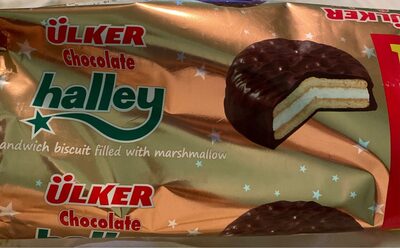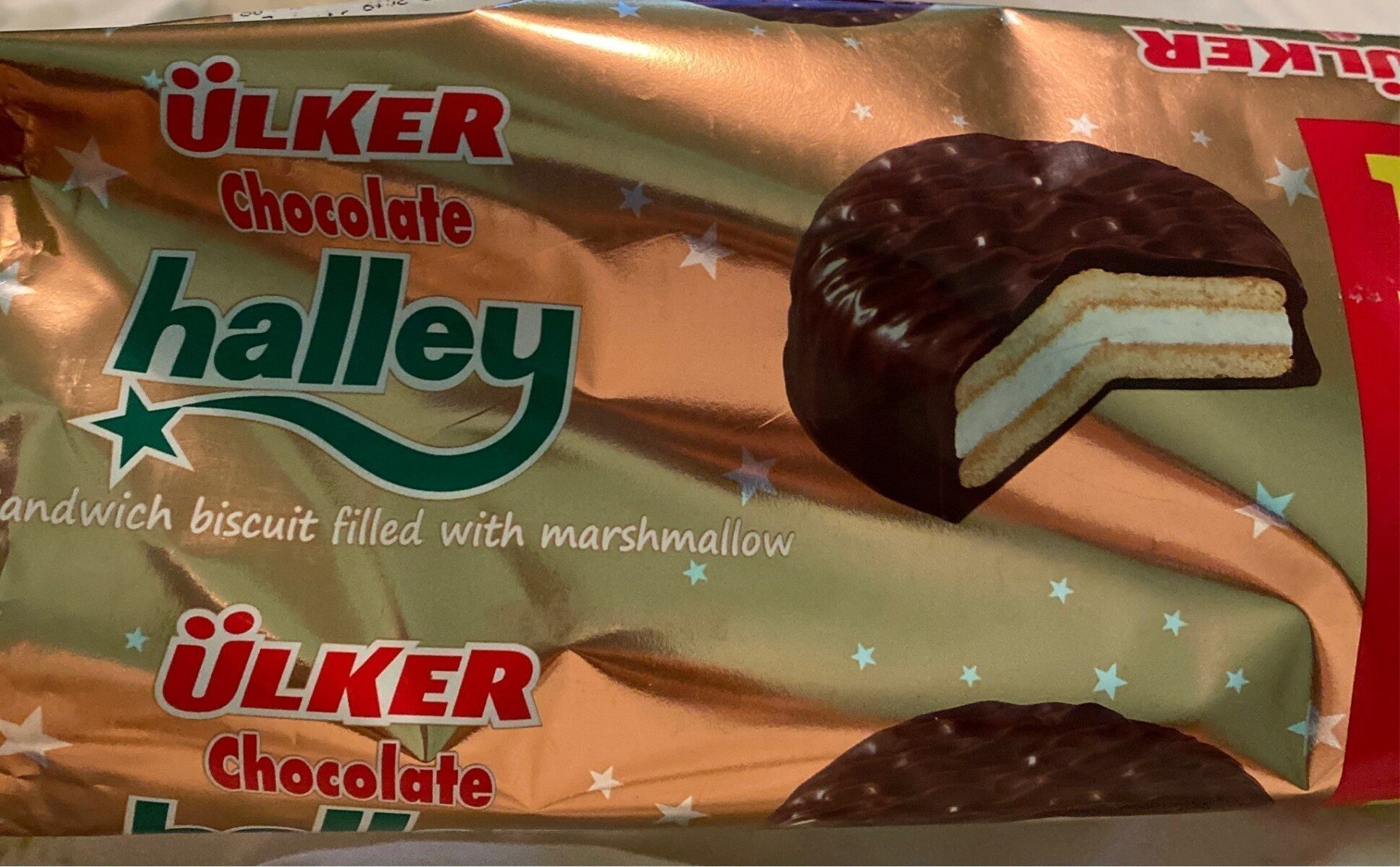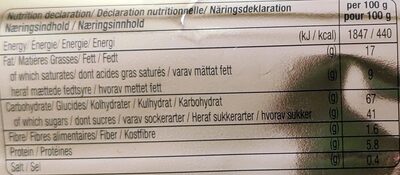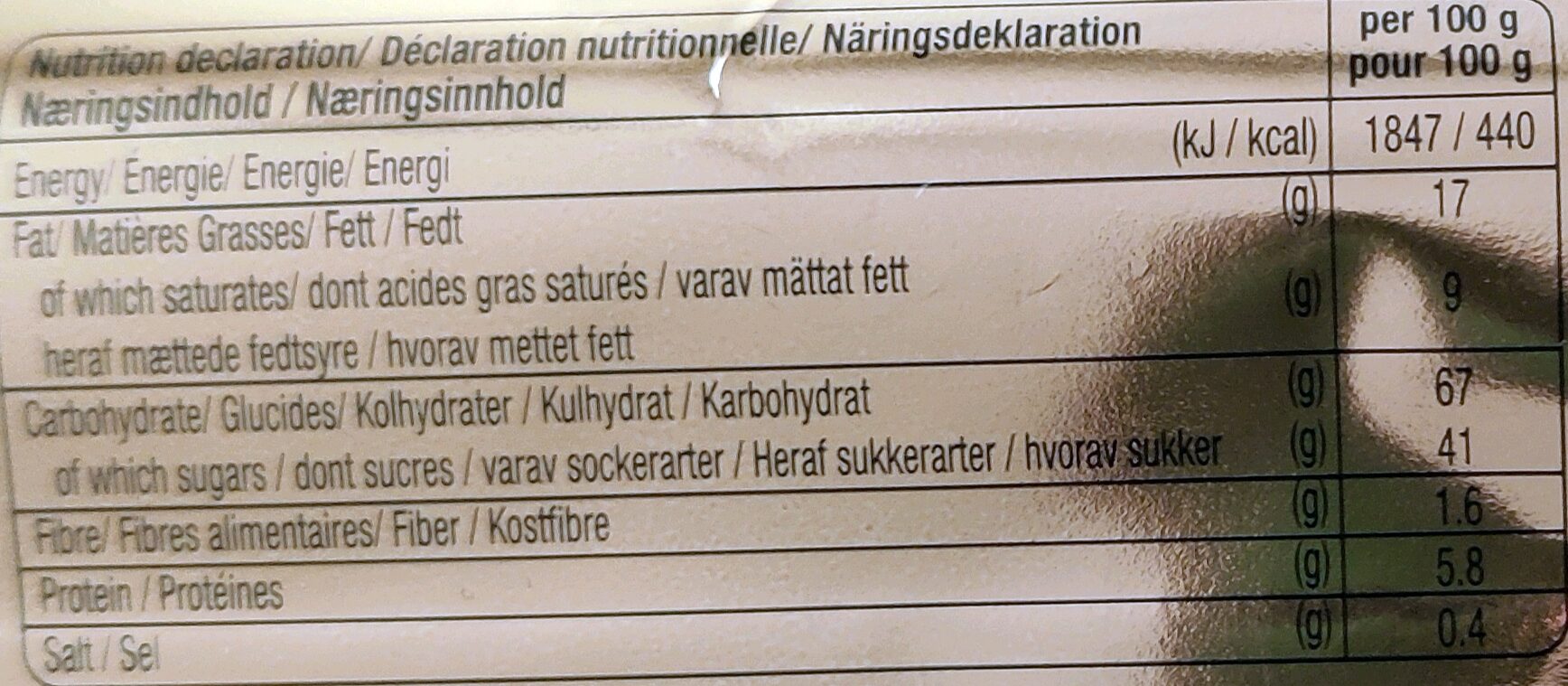Help us make food transparency the norm!
As a non-profit organization, we depend on your donations to continue informing consumers around the world about what they eat.
The food revolution starts with you!
Chocolate halley - Ülker
Chocolate halley - Ülker
This product page is not complete. You can help to complete it by editing it and adding more data from the photos we have, or by taking more photos using the app for Android or iPhone/iPad. Thank you!
×
Barcode: 8690504039556 (EAN / EAN-13)
Common name: Sandwich buscuit filled with marshmallow (23%) covered in milk chocolate (32%).
Packaging: Plastic, PP 5 - Polypropylene
Brands: Ülker
Categories: Snacks, Sweet snacks, Biscuits and cakes, Biscuits, Filled biscuits, Chocolate sandwich cookies
Labels, certifications, awards: No fat from pigs.
Manufacturing or processing places: Turkey
Stores: Woolworths, Willys
Countries where sold: Australia, Sweden, United States
Matching with your preferences
Health
Ingredients
-
28 ingredients
Sugar, wheat flour, invert sugar syrup, water, palm oil, cocoa butter, cocoa mass, whole milk powder, skimmed milk powder, raising agents (ammonium carbonates, sodium carbonates, diphosphates), humectant (sorbitols), beef gelatine, emulsifiers (soy lecithins, ammonium phosphatides, polyglycerol polyricinoleate), salt, flavourings (contain milk), acidity regulator (citric acid), flour treatment agent (sodium metabisulphite), egg, hazelnuts.Allergens: Eggs, Gluten, Milk, Nuts, SoybeansTraces: Nuts, Sesame seeds
Food processing
-
Ultra processed foods
Elements that indicate the product is in the 4 - Ultra processed food and drink products group:
- Additive: E322 - Lecithins
- Additive: E420 - Sorbitol
- Additive: E428 - Gelatine
- Additive: E442 - Ammonium phosphatides
- Additive: E450 - Diphosphates
- Additive: E476 - Polyglycerol polyricinoleate
- Ingredient: Emulsifier
- Ingredient: Flavouring
- Ingredient: Humectant
- Ingredient: Invert sugar
Food products are classified into 4 groups according to their degree of processing:
- Unprocessed or minimally processed foods
- Processed culinary ingredients
- Processed foods
- Ultra processed foods
The determination of the group is based on the category of the product and on the ingredients it contains.
Additives
-
E223 - Sodium metabisulphite
Sodium metabisulfite: Sodium metabisulfite or sodium pyrosulfite -IUPAC spelling; Br. E. sodium metabisulphite or sodium pyrosulphite- is an inorganic compound of chemical formula Na2S2O5. The substance is sometimes referred to as disodium metabisulfite. It is used as a disinfectant, antioxidant, and preservative agent.Source: Wikipedia
-
E322 - Lecithins
Lecithins are natural compounds commonly used in the food industry as emulsifiers and stabilizers.
Extracted from sources like soybeans and eggs, lecithins consist of phospholipids that enhance the mixing of oil and water, ensuring smooth textures in various products like chocolates, dressings, and baked goods.
They do not present any known health risks.
-
E330 - Citric acid
Citric acid is a natural organic acid found in citrus fruits such as lemons, oranges, and limes.
It is widely used in the food industry as a flavor enhancer, acidulant, and preservative due to its tart and refreshing taste.
Citric acid is safe for consumption when used in moderation and is considered a generally recognized as safe (GRAS) food additive by regulatory agencies worldwide.
-
E420 - Sorbitol
Sorbitol: Sorbitol --, less commonly known as glucitol --, is a sugar alcohol with a sweet taste which the human body metabolizes slowly. It can be obtained by reduction of glucose, which changes the aldehyde group to a hydroxyl group. Most sorbitol is made from corn syrup, but it is also found in nature, for example in apples, pears, peaches, and prunes. It is converted to fructose by sorbitol-6-phosphate 2-dehydrogenase. Sorbitol is an isomer of mannitol, another sugar alcohol; the two differ only in the orientation of the hydroxyl group on carbon 2. While similar, the two sugar alcohols have very different sources in nature, melting points, and uses.Source: Wikipedia
-
E442 - Ammonium phosphatides
Mixed ammonium salts of phosphorylated glycerides: The mix of ammonium salts of phosphorylated glycerides can be either made synthetically or from mixture of glycerol and partially hardened plant -most often used: rapeseed oil- oils.Source: Wikipedia
-
E450 - Diphosphates
Diphosphates (E450) are food additives often utilized to modify the texture of products, acting as leavening agents in baking and preventing the coagulation of canned food.
These salts can stabilize whipped cream and are also found in powdered products to maintain their flow properties. They are commonly present in baked goods, processed meats, and soft drinks.
Derived from phosphoric acid, they're part of our daily phosphate intake, which often surpasses recommended levels due to the prevalence of phosphates in processed foods and drinks.
Excessive phosphate consumption is linked to health issues, such as impaired kidney function and weakened bone health. Though diphosphates are generally regarded as safe when consumed within established acceptable daily intakes, it's imperative to monitor overall phosphate consumption to maintain optimal health.
-
E476 - Polyglycerol polyricinoleate
Polyglycerol polyricinoleate: Polyglycerol polyricinoleate -PGPR-, E476, is an emulsifier made from glycerol and fatty acids -usually from castor bean, but also from soybean oil-. In chocolate, compound chocolate and similar coatings, PGPR is mainly used with another substance like lecithin to reduce viscosity. It is used at low levels -below 0.5%-, and works by decreasing the friction between the solid particles -e.g. cacao, sugar, milk- in molten chocolate, reducing the yield stress so that it flows more easily, approaching the behaviour of a Newtonian fluid. It can also be used as an emulsifier in spreads and in salad dressings, or to improve the texture of baked goods. It is made up of a short chain of glycerol molecules connected by ether bonds, with ricinoleic acid side chains connected by ester bonds. PGPR is a yellowish, viscous liquid, and is strongly lipophilic: it is soluble in fats and oils and insoluble in water and ethanol.Source: Wikipedia
-
E500 - Sodium carbonates
Sodium carbonates (E500) are compounds commonly used in food preparation as leavening agents, helping baked goods rise by releasing carbon dioxide when they interact with acids.
Often found in baking soda, they regulate the pH of food, preventing it from becoming too acidic or too alkaline. In the culinary world, sodium carbonates can also enhance the texture and structure of foods, such as noodles, by modifying the gluten network.
Generally recognized as safe, sodium carbonates are non-toxic when consumed in typical amounts found in food.
-
E503 - Ammonium carbonates
Ammonium carbonate: Ammonium carbonate is a salt with the chemical formula -NH4-2CO3. Since it readily degrades to gaseous ammonia and carbon dioxide upon heating, it is used as a leavening agent and also as smelling salt. It is also known as baker's ammonia and was a predecessor to the more modern leavening agents baking soda and baking powder. It is a component of what was formerly known as sal volatile and salt of hartshorn.Source: Wikipedia
Ingredients analysis
-
Palm oil
Ingredients that contain palm oil: Palm oil
-
Non-vegan
Non-vegan ingredients: Whole milk powder, Skimmed milk powder, Beef gelatin, Egg
-
Non-vegetarian
Non-vegetarian ingredients: Beef gelatin
-
Details of the analysis of the ingredients
: Sugar, wheat flour, invert sugar syrup, water, palm oil, cocoa butter, cocoa mass, whole milk powder, skimmed milk powder, raising agents (ammonium carbonates, sodium carbonates, diphosphates), humectant (sorbitols), beef gelatine, emulsifiers (soy lecithins, ammonium phosphatides, polyglycerol polyricinoleate), salt, flavourings, acidity regulator (citric acid), flour treatment agent (sodium metabisulphite), egg, hazelnuts- Sugar -> en:sugar - vegan: yes - vegetarian: yes - ciqual_proxy_food_code: 31016 - percent_min: 5.26315789473684 - percent_max: 100
- wheat flour -> en:wheat-flour - vegan: yes - vegetarian: yes - ciqual_proxy_food_code: 9410 - percent_min: 0 - percent_max: 50
- invert sugar syrup -> en:invert-sugar-syrup - vegan: yes - vegetarian: yes - percent_min: 0 - percent_max: 33.3333333333333
- water -> en:water - vegan: yes - vegetarian: yes - ciqual_food_code: 18066 - percent_min: 0 - percent_max: 25
- palm oil -> en:palm-oil - vegan: yes - vegetarian: yes - from_palm_oil: yes - ciqual_food_code: 16129 - percent_min: 0 - percent_max: 20
- cocoa butter -> en:cocoa-butter - vegan: yes - vegetarian: yes - ciqual_food_code: 16030 - percent_min: 0 - percent_max: 16.6666666666667
- cocoa mass -> en:cocoa-paste - vegan: yes - vegetarian: yes - ciqual_proxy_food_code: 16030 - percent_min: 0 - percent_max: 14.2857142857143
- whole milk powder -> en:whole-milk-powder - vegan: no - vegetarian: yes - ciqual_food_code: 19021 - percent_min: 0 - percent_max: 12.5
- skimmed milk powder -> en:skimmed-milk-powder - vegan: no - vegetarian: yes - ciqual_food_code: 19054 - percent_min: 0 - percent_max: 11.1111111111111
- raising agents -> en:raising-agent - percent_min: 0 - percent_max: 10
- ammonium carbonates -> en:e503 - vegan: yes - vegetarian: yes - percent_min: 0 - percent_max: 10
- sodium carbonates -> en:e500 - vegan: yes - vegetarian: yes - percent_min: 0 - percent_max: 5
- diphosphates -> en:e450 - vegan: yes - vegetarian: yes - percent_min: 0 - percent_max: 3.33333333333333
- humectant -> en:humectant - percent_min: 0 - percent_max: 9.09090909090909
- sorbitols -> en:e420 - vegan: yes - vegetarian: yes - percent_min: 0 - percent_max: 9.09090909090909
- beef gelatine -> en:beef-gelatin - vegan: no - vegetarian: no - percent_min: 0 - percent_max: 8.33333333333333
- emulsifiers -> en:emulsifier - percent_min: 0 - percent_max: 7.69230769230769
- soy lecithins -> en:soya-lecithin - vegan: yes - vegetarian: yes - ciqual_food_code: 42200 - percent_min: 0 - percent_max: 7.69230769230769
- ammonium phosphatides -> en:e442 - vegan: maybe - vegetarian: maybe - percent_min: 0 - percent_max: 3.84615384615385
- polyglycerol polyricinoleate -> en:e476 - vegan: yes - vegetarian: yes - percent_min: 0 - percent_max: 2.56410256410256
- salt -> en:salt - vegan: yes - vegetarian: yes - ciqual_food_code: 11058 - percent_min: 0 - percent_max: 0.4
- flavourings -> en:flavouring - labels: en:contains-milk - vegan: maybe - vegetarian: maybe - percent_min: 0 - percent_max: 0.4
- acidity regulator -> en:acidity-regulator - percent_min: 0 - percent_max: 0.4
- citric acid -> en:e330 - vegan: yes - vegetarian: yes - percent_min: 0 - percent_max: 0.4
- flour treatment agent -> en:flour-treatment-agent - percent_min: 0 - percent_max: 0.4
- sodium metabisulphite -> en:e223 - vegan: yes - vegetarian: yes - percent_min: 0 - percent_max: 0.4
- egg -> en:egg - vegan: no - vegetarian: yes - ciqual_food_code: 22000 - percent_min: 0 - percent_max: 0.4
- hazelnuts -> en:hazelnut - vegan: yes - vegetarian: yes - ciqual_food_code: 15004 - percent_min: 0 - percent_max: 0.4
Nutrition
-
Bad nutritional quality
⚠ ️Warning: the amount of fruits, vegetables and nuts is not specified on the label, it was estimated from the list of ingredients: 0This product is not considered a beverage for the calculation of the Nutri-Score.
Positive points: 1
- Proteins: 3 / 5 (value: 5.8, rounded value: 5.8)
- Fiber: 1 / 5 (value: 1.6, rounded value: 1.6)
- Fruits, vegetables, nuts, and colza/walnut/olive oils: 0 / 5 (value: 0.000361392372525415, rounded value: 0)
Negative points: 23
- Energy: 5 / 10 (value: 1847, rounded value: 1847)
- Sugars: 9 / 10 (value: 41, rounded value: 41)
- Saturated fat: 8 / 10 (value: 9, rounded value: 9)
- Sodium: 1 / 10 (value: 160, rounded value: 160)
The points for proteins are not counted because the negative points are greater or equal to 11.
Nutritional score: (23 - 1)
Nutri-Score:
-
Nutrient levels
-
Fat in moderate quantity (17%)
What you need to know- A high consumption of fat, especially saturated fats, can raise cholesterol, which increases the risk of heart diseases.
Recommendation: Limit the consumption of fat and saturated fat- Choose products with lower fat and saturated fat content.
-
Saturated fat in high quantity (9%)
What you need to know- A high consumption of fat, especially saturated fats, can raise cholesterol, which increases the risk of heart diseases.
Recommendation: Limit the consumption of fat and saturated fat- Choose products with lower fat and saturated fat content.
-
Sugars in high quantity (41%)
What you need to know- A high consumption of sugar can cause weight gain and tooth decay. It also augments the risk of type 2 diabetes and cardio-vascular diseases.
Recommendation: Limit the consumption of sugar and sugary drinks- Sugary drinks (such as sodas, fruit beverages, and fruit juices and nectars) should be limited as much as possible (no more than 1 glass a day).
- Choose products with lower sugar content and reduce the consumption of products with added sugars.
-
Salt in moderate quantity (0.4%)
What you need to know- A high consumption of salt (or sodium) can cause raised blood pressure, which can increase the risk of heart disease and stroke.
- Many people who have high blood pressure do not know it, as there are often no symptoms.
- Most people consume too much salt (on average 9 to 12 grams per day), around twice the recommended maximum level of intake.
Recommendation: Limit the consumption of salt and salted food- Reduce the quantity of salt used when cooking, and don't salt again at the table.
- Limit the consumption of salty snacks and choose products with lower salt content.
-
-
Nutrition facts
Nutrition facts As sold
for 100 g / 100 mlAs sold
per serving (30 g)Compared to: Chocolate sandwich cookies Energy 1,847 kj
(440 kcal)554 kj
(132 kcal)-8% Fat 17 g 5.1 g -17% Saturated fat 9 g 2.7 g -0% Carbohydrates 67 g 20.1 g -1% Sugars 41 g 12.3 g +14% Fiber 1.6 g 0.48 g -42% Proteins 5.8 g 1.74 g +18% Salt 0.4 g 0.12 g -50% Fruits‚ vegetables‚ nuts and rapeseed‚ walnut and olive oils (estimate from ingredients list analysis) 0 % 0 %
Environment
-
Eco-Score D - High environmental impact
⚠ ️Select a country in order to include the full impact of transportation.The Eco-Score is an experimental score that summarizes the environmental impacts of food products.→ The Eco-Score was initially developped for France and it is being extended to other European countries. The Eco-Score formula is subject to change as it is regularly improved to make it more precise and better suited to each country.Life cycle analysis
-
Average impact of products of the same category: C (Score: 56/100)
Category: Biscuit (cookie), snack with dairy or vanilla filling
Category: Biscuit (cookie), snack with dairy or vanilla filling
- PEF environmental score: 0.47 (the lower the score, the lower the impact)
- including impact on climate change: 5.92 kg CO2 eq/kg of product
Stage Impact Agriculture
63.6 %Processing
29.8 %Packaging
2.3 %Transportation
3.2 %Distribution
1.0 %Consumption
0.0 %
Bonuses and maluses
-
Missing origins of ingredients information
Malus: -5
⚠ ️ The origins of the ingredients of this product are not indicated.
If they are indicated on the packaging, you can modify the product sheet and add them.
If you are the manufacturer of this product, you can send us the information with our free platform for producers.
-
Ingredients that threatens species
Malus: -10
Contains palm oil
Tropical forests in Asia, Africa and Latin America are destroyed to create and expand oil palm tree plantations. The deforestation contributes to climate change, and it endangers species such as the orangutan, the pigmy elephant and the Sumatran rhino.
-
Missing packaging information for this product
Malus: -15
⚠ ️ The information about the packaging of this product is not filled in.⚠ ️ For a more precise calculation of the Eco-Score, you can modify the product page and add them.
If you are the manufacturer of this product, you can send us the information with our free platform for producers.
Eco-Score for this product
-
Impact for this product: D (Score: 26/100)
Product: Chocolate halley - Ülker
Life cycle analysis score: 56
Sum of bonuses and maluses: -30
Final score: 26/100
-
Carbon footprint
-
Equal to driving 3.1 km in a petrol car
592 g CO² per 100g of product
The carbon emission figure comes from ADEME's Agribalyse database, for the category: Biscuit (cookie), snack with dairy or vanilla filling (Source: ADEME Agribalyse Database)
Stage Impact Agriculture
52.9 %Processing
42.0 %Packaging
1.9 %Transportation
2.9 %Distribution
0.3 %Consumption
0.0 %
Packaging
-
Missing packaging information for this product
⚠ ️ The information about the packaging of this product is not filled in.Take a photo of the recycling information Take a photo of the recycling information
Transportation
-
Origins of ingredients
Missing origins of ingredients information
⚠ ️ The origins of the ingredients of this product are not indicated.
If they are indicated on the packaging, you can modify the product sheet and add them.
If you are the manufacturer of this product, you can send us the information with our free platform for producers.Add the origins of ingredients for this product Add the origins of ingredients for this product
Threatened species
-
Contains palm oil
Drives deforestation and threatens species such as the orangutan
Tropical forests in Asia, Africa and Latin America are destroyed to create and expand oil palm tree plantations. The deforestation contributes to climate change, and it endangers species such as the orangutan, the pigmy elephant and the Sumatran rhino.
Report a problem
-
Incomplete or incorrect information?
Category, labels, ingredients, allergens, nutritional information, photos etc.
If the information does not match the information on the packaging, please complete or correct it. Open Food Facts is a collaborative database, and every contribution is useful for all.
Data sources
Product added on by kiliweb
Last edit of product page on by akitainu.
Product page also edited by archanox, inf, roboto-app, yuka.YUtJNFA2MG4rZmhTcGZJNjJSai9wK01xNWFTUmNHcUpOTTBPSWc9PQ, yuka.sY2b0xO6T85zoF3NwEKvlk1YVur6ux-cFC7fn3eL9NuSDLnTUMhe8IfWHqs, yuka.sY2b0xO6T85zoF3NwEKvln5WevqCrSP9OEbVvX2J2_KzML3OedJMwKbTHKo.










